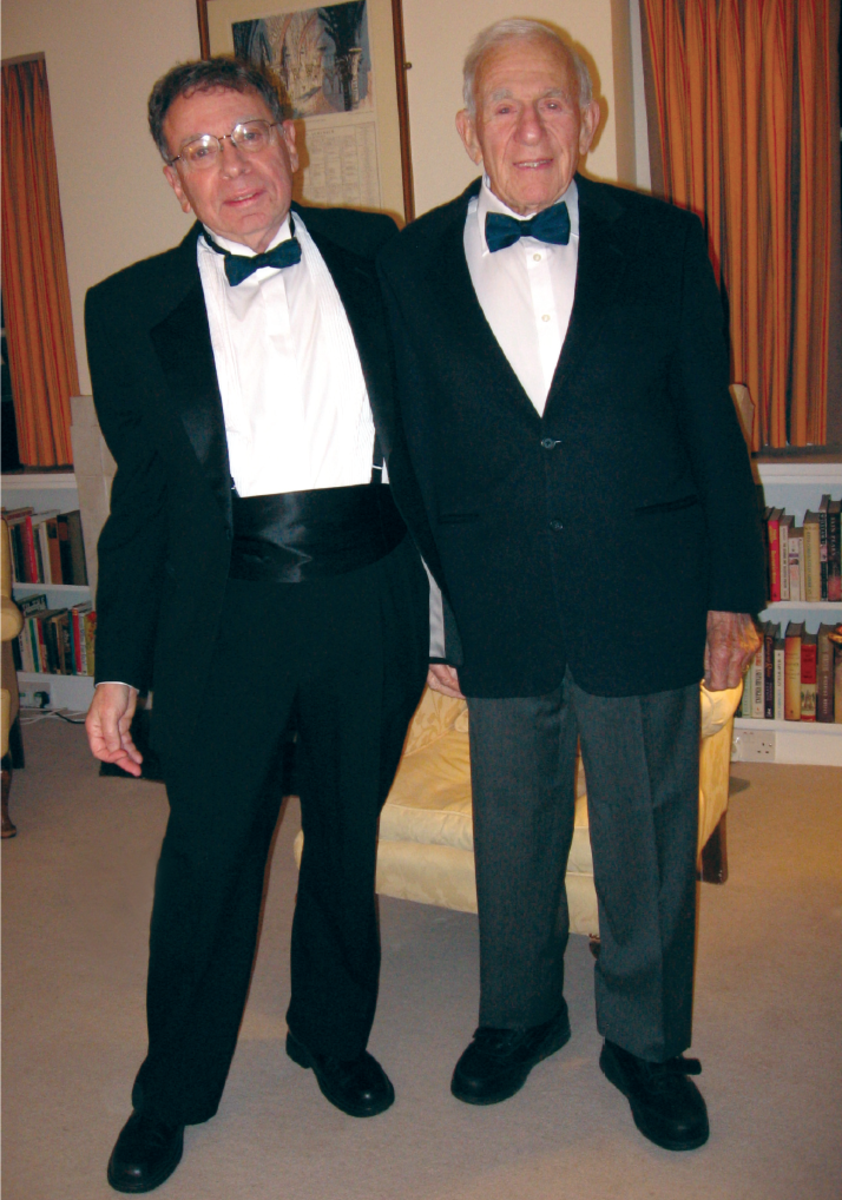PAOC Spotlights
Remembering Walter Munk

The ocean acoustics team. From left: Carl Wunsch, Professor Emeritus of Physical Oceanography, Paola Rizzoli, Professor of Physical Oceanography, Walter Munk, renowned oceanographer and geophysicist at the Scripps Institution of Oceanography, and Arthur Baggeroer, Professor Emeritus of Ocean Engineering. (Photo courtesy of Paola Rizzoli.)
On October 2, 1964, Walter Munk, renowned oceanographer and geophysicist at the Scripps Institution of Oceanography at the University of California San Diego,briefly left the West Coast for Cambridge, MA, to herald in a new era of earth science research at MIT.
The occasion: the dedication of the Cecil H. and Ida F. Green Building as the bright new home for Course XII and XIX (then the Department of Meteorology) faculty and students. At Cecil Green’s request, the event was marked by a 3-day international conference that bought together the world’s most distinguished earth and planetary scientists. The program reads as a who’s-who list of notable figures in the field: Edward Lorenz, Bengt Strömgren, Roger Revelle, Henry Stommel, and Munk, who gave a presentation on the spectrum of waves.
In attendance that day was Carl Wunsch, then a graduate student, now Cecil and Ida Green Professor Emeritus of Physical Oceanography in MIT's Department of Earth, Atmospheric and Planetary Sciences (EAPS) and PAOC member. After Munk’s presentation, Stommel, Wunsch’s thesis adviser, introduced the two scientists, sparking the beginning of what would become a 50-year professional collaboration and close friendship.
“He was one of those people who worked on a huge range of problems, across the whole oceanography and much of geophysics,” says Wunsch. “It's very hard to imagine anybody ever doing what he did again.”
At the time of their meeting, Munk was already well-respected in the fields of geophysics and physical oceanography, having had a hand in shaping some notable events in world history. During World War II, he forecasted wave conditions for the U.S, military to ensure safer naval beach landings, including the Normandy landings on D-Day. His early research at Scripps produced groundbreaking insights into ocean circulation, including how wind drives the Gulf Stream, and the rotation of the Earth, publishing the influential book “The Rotation of the Earth: A Geophysical Discussion.” In the mid-1950s, when MIT faculty felt Course XII curriculum needed an upgrade, it was Munk they brought in to advise on the new geophysics sections.
|
Walter Munk (1917-2019) Writing in Nature, Wunsch describes his long-time friend and collaborator as "an exemplar of the interplay of scientific and personal charisma." Read the full, beautifully written obiturary here.  |
When Munk returned to MIT in 1964 for the Green Building dedication ceremonies, he was just shy of his 47th birthday, an age in which many near a midpoint in their career. For Munk, it was barely a mile marker. In the next five decades, Munk would advise presidents and the Pentagon, pioneer the use of ocean acoustics to better understand climate change, and pose some of the field’s most pressing questions.
Those who knew him describe Munk as a man with many ideas and great imagination, who brought a sweep of modernity to the field of physical oceanography. Papers he wrote in the 1970s and 80s spurred whole new subfields of oceanography that continue today. Acoustic tomography, time series analysis, pole tides, the use of Fourier statistical methods: all modern areas of research born of Munk’s forward thinking and knack for asking the right questions at the right time.
“He used to say asking the right question was much more important than getting the right answer,” says Wunsch. “And he didn't always get the right answer, but he was very good at asking the right questions.”
Today, Wunsch recalls his time with Munk from his office on the 14th floor of the Green building, the same office that Munk used as a visiting scientist in the late 1960s.
“He was the most optimistic person I ever met,” says Wunch. “No matter how dark things looked, he was sure it would all work out.
Professionally, they collaborated on acoustic tomography, or ocean acoustics, a field that tracks the speed that sound waves travel through water to measure the temperature of the ocean, eventually writing a book on the subject together. Wunsch says that Munk had a fantastic ability to combine observations with theory and an intuition for physical phenomena. He also had a contagious zeal for life.
He had this very powerful personality that made everybody enthusiastic about whatever topic he was talking about,” says Wunsch.
Munk was born in Vienna 1917 and spent most of his early life in the city before being sent as a teenager to school in upstate New York, where it was assumed he would continue the family’s lineage of bankers. Instead, he traveled to California, earning a degree in applied physics from CalTech before getting his doctorate in oceanography at Scripps, where he remained until his death.
Over his long career, Munk became as well known for his gregarious personality as he was for his groundbreaking research. Wunsch says it was seldom that his home in La Jolla, CA, was void of visitors. It was common for colleagues, like Wunsch and Paola Malanotte-Rizzoli, an EAPS Professor of Physical Oceanography and PAOC member, to become close friends.
“Walter obviously had of all the prizes in the world and still he was a superbly generous and modest man,” says Malanotte-Rizzoli. “He was incredible, not only as a scientist but as a human being.”
Malanotte-Rizzoli met Munk in 1970 as a young physicist working on with a team of scientists to investigate the causes of the calamitous Venetian floods. The two bonded over a shared love of Venice.
In 1971, Malanotte-Rizzoli followed Munk to Scripps, where she spent much of the next decade of her life working alongside him. She says Munk encouraged her early research on chaos theory at a time when American scientific institutions were not always welcoming to women. Later, as a professor at MIT, Malanotte-Rizzoli would collaborate with Munk and Wunsch on acoustic tomography research.
“He always really supported me and followed my career,” says Malanotte-Rizzoli. “He was a great friend, and I loved him very much.”
His charisma and sociable nature didn’t wane in his later years. Both Wunsch and Malanotte-Rizzoli recall Munk’s seemingly infinite energy: working well into his 90s, traveling the world at the age of 100, giving speeches at his centennial birthday celebrations. Even as the lifetime achievement awards rolled in, he remained humble and gracious.
In an interview with Wunsch published last year in the Annual Review of Marine Science, Munk said of his career: “My career has been very much dictated by circumstances. I’m interested in what’s happening and respond to it and have had a very good time doing it.”
On February 8, 2019, at the age of 101, the revered researcher passed away in his home La Jolla, CA. His rich life will be a bright spot in the history of modern physical oceanography and geophysics, transforming our understanding of the oceans and heralding in a new era of earth sciences at MIT and beyond.
Cited works
Hurley PM. Advances in Earth Science; Contributions. Cambridge, Mass., M.I.T. Press [1966]; 1966.
Munk W, Wunsch C. A Conversation with Walter Munk. Ann Rev Mar Sci. 2019 Jan 3;11:15-25. doi: 10.1146/annurev-marine-010318-095353. Epub 2018 May 11.
Shrock RR. Geology at M.I.T., 1865-1965 : A History of the First Hundred Years of Geology at Massachusetts Institute of Technology. Cambridge : MIT Press, c1977-; 1977.